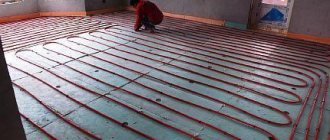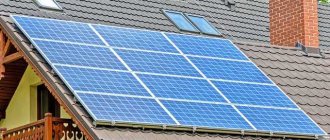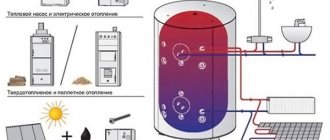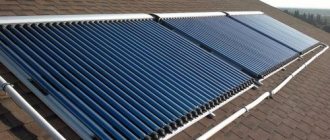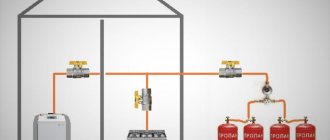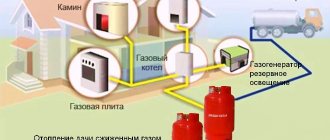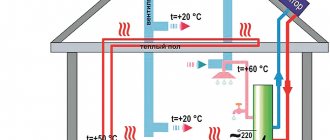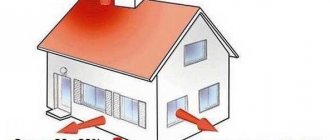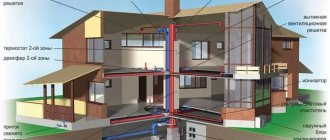Despite the boom in suburban construction, gasification of such areas is proceeding at a rather low pace. Almost all developers in suburban areas are faced with the choice of how to reliably and inexpensively organize a heating system in a new house, without gas or electricity. The latter energy carrier, even if it is already available in new buildings, is very expensive, and in addition, not all consumers have a three-phase connection, which is required for many powerful electric boilers. Therefore, owners of homestead housing constructions are looking for alternative home heating without gas and electricity.
Heat pumps
Heat pumps are a very real alternative to traditional heat generators and boilers.
The operating principle of this energy-saving system is somewhat reminiscent of an air conditioner, which transfers heat from indoors to outdoors. A heat pump transfers heat from the ground into a heated room and transfers cold back.
When a heat pump operates, energy is not spent on generating heat, but solely on moving it.
Heat pump operation diagram. Click to enlarge.
The functionality of this system makes it possible to obtain approximately 4.5 kW of thermal energy, spending only 1 kW of electrical energy on its transportation.
Heat pumps are highly efficient, reliable and cost-effective. Alternative heating of the described type has only one significant drawback - the decision to install it should be made only at the zero construction cycle.
This requirement is dictated by the large volume of excavation work.
Solar collectors
Despite the fact that heating a country house with solar panels is almost impossible in harsh climates, it is impossible not to consider this type of alternative source of energy and heat.
The greatest efficiency can be achieved only with intense solar radiation - only in this case the temperature in the premises will be as comfortable as possible.
Varieties
Solar systems for heating the coolant (in our case it is a water-glycol solution) can be divided into passive and active.
The first ones are combined into one so-called “water heater”, which is located on the roof. The coolant reservoir is located above the collector level, and cold water is supplied to the tank from below.
Scheme of operation of a flat solar collector. Click to enlarge.
The latter have a structural difference from passive solar heating systems: the solar collectors themselves are placed on the roof of the house, and the coolant reservoir is located in the house.
The coolant is water, circulates in the heating system using a pump.
Most often, solar collectors are used for household needs - heating water in storage tanks.
But in this case, in winter you will have to drain all the water from the tank to avoid freezing.
There are two different types of solar collectors: flat plate and vacuum (tube).
A flat-plate collector is a solar absorber with glazing on the top, having a layer of foil-coated thermal insulation on the inside.
Diagram of the operation of a pipe manifold. Click to enlarge.
The absorber is a flat sheet of metal connected to a piping system.
It “collects” solar heat, transferring it to the coolant. The glass should not reflect glare - to achieve maximum effect from light energy.
A tube collector differs from a flat one only in the presence of vacuum glass pipes collected in one bundle.
An absorber made of a sheet of steel is inserted into each tube - it can be rotated inside to even out the sunlight.
Tube solar collectors are more expensive to install and maintain, but they provide a greater effect than flat ones due to longer retention of solar heat.
Both types of heating systems are mounted on the roof of the house - in the inclined part.
Recently, manufacturers have been offering so-called “solar” roofs, in which solar panels are already installed, but this option has not become widespread due to the leakage of the roof covering.
3) Hydrogen energy
Hydrogen energy provides more power than gasoline and diesel fuel provide to vehicles. Yes, hydrogen is chemically extracted from fossil fuels. But this type of fuel does not release gases and does not destroy ozone. With certain technologies, hydrogen is a clean source of fuel combustion.
To harness the full power of hydrogen, hydrogen power plants today rely on auxiliary chemicals such as coal, natural gas and other fossil carbons to power the turbine needed to create clean hydrogen energy. But the hydrogen turbine will soon be powered by solar energy instead of fossil fuels, eliminating the need to burn dirty fuel.
Heat pumps
In this case, the fuel and energy resources can be water-water or brine-water pairs.
"Water-water"
The principle of operation of such heating is as follows: water taken from an earthen well is pumped through a heat pump, and with its thermal energy it supplies heat to the house. The waste water is discharged into the ground.
In order for this scheme to work flawlessly for a house with an area of up to 80 m2, the owner of the house will need to drill at least two water intake and drainage wells, the depth of which is 50 m or more.
"Brine-water"
The principle diagram of heating with a heat pump with brine-water fuel is somewhat different: the thermal energy of the fuel is a solution placed in U-shaped pipes.
Schematic diagram of the operation of a heat pump. Click to enlarge.
The pipes must be placed in a drilled well at a depth of at least 150 m, or a heat exchanger must be constructed from the pipes, which will be located at a depth of 5 m and below. This will be needed in order to reduce temperature differences at different times of the year.
Both the number of wells and their size will be determined on the basis of 50 W/mp, i.e., 50 W of thermal energy can be obtained from each linear meter of one well. In the case of installing a heat exchanger, the calculation is slightly different - 40 W/m2 of the heat exchanger area, taking into account the interpipe distance of up to 800 mm.
The leader in the amount of capital investment for heating a private house with a heat pump has a longer payback period, but the costs of operating and maintaining the equipment will be minimal compared to other types of heating systems.
Waste oils
Another type can be called alternative energy sources such as waste oils.
And, although this type of fuel and energy resource is not renewable and is often disposed of - collected, stored, transported, processed - many manufacturers of home heating boilers use waste oils as fuel (in the production of multi-fuel boilers).
Why oils? Because their caloric content exceeds the caloric content of other types of fuel - diesel fuel, coal, wood. Disadvantages: the need for a special storage container to store reserve stock; alternative fuel must be of proper quality.
Advantages of using heat pumps
Saving. If you compare the costs of heating using a heat pump with the costs of gas equipment, you will get an impressive amount with a difference in favor of pumps. And all because alternative sources in the heating system are the thermal energy of water and earth.
Safe work. Regarding the explosion and fire hazard of heating equipment running on gas, an electric heat pump for heating a house is a completely harmless device! This also includes the ease of operation of the equipment.
Versatility of use. A heat pump can work both for heating and cooling rooms (something akin to the operation of split systems in “hot-cold” modes).
Full automation of work. Unlike solid fuel boilers, heat pumps do not require constant loading of fuel, and they do not require constant monitoring, inspection, or cleaning.
And the heat pump does not require a connection to the main gas pipeline - this is autonomous heating of a country house, which is provided by a simple connection to the power supply network.
9) Hydroelectricity
Hydroelectric power plants are very popular all over the world. It is noteworthy that in some countries hydroelectric power plants provide the population with 75 percent of the required energy.
For example, the hydroelectric dam in Itaipu (Paraguay) supplies 90 percent of the country's energy needs. In addition, this plant provides energy to Brazil, supplying 20 percent of the electricity needed by all of Brazil. The power of hydro turbines accounts for 10 percent of all hydroelectric power capacity worldwide.
The first large hydroelectric power station opened at Niagara Falls on the US-Canadian border in 1879. The dam provides cleaner energy generation.
Currently, the cost of hydroelectric power is less than half the cost of energy produced from solar panels and three times less than the cost of thermal energy.
Also, hydropower has a higher efficiency than when burning coal and gas. For example, the efficiency of fossil carbon is 50 percent, while the efficiency of hydroelectric power plants is 90 percent. In addition, almost all water used to operate electric turbines is returned to reserve storage.
Heat pumps
The most universal alternative heating for a private home is the installation of heat pumps. They work on the well-known principle of a refrigerator, taking heat from a colder body and releasing it in the heating system.
The circuit is complex at first glance and consists of three devices: an evaporator, a heat exchanger and a compressor. There are a huge number of options for implementing heat pumps, but the most popular are:
The cheapest implementation option is air-to-air. In essence, it resembles a classic split system, but electricity is spent only on pumping heat from the street into the house, and not on heating air masses. This helps save money while keeping your home perfectly warm throughout the year.
The efficiency of the systems is very high. For 1 kW of electricity you can get up to 6-7 kW of heat. Modern inverters work great even at temperatures of -25 degrees and below.
“Air-water” is one of the common implementations of a heat pump, in which the role of a heat exchanger is played by a large-area coil installed in an open area. Additionally, it can be blown by a fan, causing the water inside to cool.
Such installations are characterized by a more affordable cost and simple installation. But they are capable of operating with high efficiency only at temperatures from +7 to +15 degrees. When the bar drops to a negative level, efficiency drops.
The most universal implementation of a heat pump is “ground-water”. It does not depend on the climate zone, since a layer of soil that does not freeze throughout the year is available everywhere.
In this scheme, the pipes are immersed into the ground to a depth where the temperature is maintained at 7-10 degrees throughout the year. Collectors can be located vertically or horizontally. In the first case, it is necessary to drill several very deep wells, in the second, to lay the coil at a certain depth.
The disadvantage is obvious. complex installation work that will require high financial investments. Before deciding to take such a step, you should calculate the economic benefits. In areas with short, warm winters, it is worth considering other options for alternative heating of private houses. Another limitation is that a large free area is required - up to several tens of square meters. m.
The implementation of a water-to-water heat pump is practically no different from the previous one, however, the collector pipes are laid in groundwater, which does not freeze throughout the year, or in a nearby body of water. It is cheaper due to the following advantages:
- Maximum well drilling depth – 15 m
- You can get by with 1-2 submersible pumps
Biofuel boilers
If there is no desire and opportunity to equip a complex system consisting of pipes in the ground, solar modules on the roof, you can replace the classic boiler with a model that runs on biological fuel. They require:
It is recommended to install such installations in conjunction with the previously discussed alternative sources. In situations where one of the heating devices does not work, you can use the second one.
When deciding on the installation and subsequent operation of alternative sources of thermal energy, it is necessary to answer the question: how quickly will they pay for themselves? Of course, the systems considered have advantages, including:
- The cost of energy produced is less than using traditional sources
- High efficiency
However, you should be aware of the high initial material costs, which can reach tens of thousands of dollars. The installation of such installations cannot be called simple, so the work is entrusted exclusively to a professional team that can provide a guarantee on the result.
Alternative heating of a private home is becoming in demand, which is becoming more profitable against the backdrop of rising prices for traditional sources of thermal energy. However, before you start converting your current heating system, you need to calculate everything by considering each of the proposed options.
It is also not recommended to abandon the traditional boiler. It must be left and in certain situations, when alternative heating does not fulfill its functions, it will remain possible to warm your home and not freeze
Stormy streams
The need for an energy transition is obvious to the Russian authorities. “The world economy is aimed at a gradual transition to low-carbon energy. And this is already a new reality. We need to prepare for a gradual reduction in the use of traditional fuels - oil, gas, coal. Increase energy efficiency. Develop alternative energy. Build appropriate infrastructure,” said Prime Minister Mikhail Mishustin. By mid-December 2022, a plan will be developed to adapt the economy to new realities until 2030. One of the key areas should be the development of those areas where the country has advantages: the use of hydrogen, coal chemistry, climate projects in forestry, nuclear and hydropower.
Currently, there are more than 170 hydroelectric power plants (HPPs) operating in Russia. In terms of installed capacity, they occupy second place after thermal power plants, but the share of their generation in the country’s energy balance is 17.6 percent, and in terms of this indicator they are still inferior to gas, coal and nuclear power plants. At the same time, the energy obtained from hydroelectric power plants is one of the cheapest: one kilowatt costs about 0.15 rubles. The country's largest hydroelectric power station, Sayano-Shushenskaya, is located in Siberia and provides three percent of the energy consumption of all of Russia. In 2022, it produced a record 26.6 billion kilowatt-hours: this is enough to power the entire St. Petersburg.
About nine percent of the world's hydropower reserves are concentrated in Russia. In terms of hydropower resources, Russia ranks second in the world, ahead of the USA, Brazil, Canada and second only to China. However, the degree of development of our country's hydropower potential is only about 20 percent. The development of hydropower is hampered for several reasons. Firstly, the cost of constructing a hydroelectric power station is very high and exceeds investments in solar and wind power plants, and in some cases it may even be more expensive than the construction of a nuclear power plant. Secondly, most of the places suitable for the construction of hydroelectric power stations have already been used. And installing hydroelectric power plants in hard-to-reach and potentially dangerous places, for example, in a seismically risky zone, increases already high costs. In addition, in areas where there are hydroelectric power stations, the microclimate changes, and nearby areas can turn into swamps.
20 per cent
Russia uses hydropotential to generate electricity
The solution could be mini-hydroelectric power plants with a capacity of up to 30 megawatts. “Small and medium-sized hydroelectric power plants do not have such a strong impact on the environment; they can be located on smaller rivers and require less investment,” explains Natalya Churkina, an analyst at the Institute for Comprehensive Strategic Studies.
By the end of 2024, Russia plans to commission several small hydroelectric power plants with a total capacity of 168 megawatts. For example, in Chechnya they began to build a Tower Small Hydroelectric Power Plant (SHPP) with a capacity of 10 megawatts on the Argun River, the main goal of the project is to improve energy supply in mountainous areas. It is expected that the station will generate 45 million kilowatt-hours of clean energy per year. The project cost almost two billion rubles, and the small hydroelectric power station should be launched in 2024. Another promising project is a mini-hydroelectric power station in Dagestan, which will cost 1.5 billion rubles and should be launched by the end of 2024. In 2028, the republic will also have the Mogokh hydroelectric power station with a capacity of 49.8 megawatts; the final cost of the station has not yet been determined.
Radiators and heating pipes
In addition to modern heating boilers, pipes and radiators are no less important components. They are necessary for the efficient transfer of thermal energy to the air in the room. During the design of the system, it is necessary to solve two problems - to reduce heat losses when transporting coolant through pipes and to improve the heat transfer of batteries.
Any modern heating radiators must not only have good heat transfer performance, but also a design that is convenient for repair and maintenance. The same applies to pipelines. Their installation should not be difficult. Ideally, the installation can be carried out by the home owner himself without the use of expensive equipment.
Modern heating radiators
Design of heating radiators
To increase heat transfer, aluminum is increasingly being used as the main material for batteries. It has good thermal conductivity, and casting or welding technology can be used to obtain the desired shape.
But you need to keep in mind that aluminum is very sensitive to water. Modern cast iron heating radiators do not have this drawback, although they have lower energy intensity. To solve this problem, a new battery design was developed in which the water channels are made of steel or copper pipes.
These modern heating pipes are practically not subject to corrosion, having minimal dimensions and wall thickness. The latter is necessary for efficient thermal transfer of energy from hot water to aluminum. Modern heating radiators have several advantages, which are as follows:
- Long service life - up to 40 years. However, it depends on operating conditions and timely cleaning of the system;
- Possibility of choosing a connection method – top, bottom or side;
- The package may include a Mayevsky faucet and a thermostat.
In most cases, models of modern cast iron heating radiators are designed to be designer. They have classic shapes, some of them are made in a floor version with elements of artistic forging.
The efficiency of a heating radiator depends on correct installation and connection method. This must be taken into account when installing the system.
Modern heating pipes
Polymer pipes for heating
The choice of modern heating pipes largely depends on the material they are made of. Currently, polymer lines made of polypropylene or cross-linked polyethylene are most often used. They have an additional reinforcing layer of aluminum foil or fiberglass.
However, they have one significant drawback - a relatively low temperature threshold of up to +90°C. This entails a large temperature expansion and, as a result, damage to the pipeline. An alternative to polymer pipes can be products made from other materials:
- Copper. From a functional point of view, copper pipes meet all the requirements for a heating system. They are easy to install and practically do not change shape even at extremely high coolant temperatures. Even when water freezes, the walls of copper lines will expand without damage. Disadvantage: high cost;
- Stainless steel. It does not rust, its inner surface has a minimum roughness coefficient. Disadvantages include cost and labor-intensive installation.
How to choose the optimal equipment for modern heating? To do this, it is necessary to use an integrated approach - make the correct calculation of the system and, according to the data obtained, select a boiler, pipes and radiators with the appropriate performance characteristics.
The video shows an example of modern home heating using a heated floor system:
Pellet fireplaces
Pellet fireplaces differ from simple air fireplaces in the design of the combustion chamber. It allows you to use pellets as the main fuel and supply them automatically. At the same time, the high fuel combustion coefficient significantly reduces the requirements for the chimney and natural draft. Based on the principle of operation, several advantages of such heating equipment can be identified:
- Well, you need complex installation or architectural modifications. Such fireplaces can be installed even in rooms without communications, and the chimney is routed directly through the wall (and not vertically upward);
- feeding automation simplifies equipment maintenance and increases cycle time.
The disadvantages include the following:
- A pellet fireplace can only heat the room where it is installed. It will not be enough to heat the entire house;
- storing a large supply of pellets may require a separate room;
- The efficiency of combustion and heating depends on the quality of the pellets.
In addition, you need to take into account that manufacturers of pellet fireplaces for each model strictly stipulate the permissible dimensions of the pellet - the length and diameter of the pellet. Therefore, not every fuel is suitable.
Ground-to-water heat pumps
These devices are the most versatile alternative sources of heating for suburban households in terms of dependence on the climate zone.
The principle of their operation is based on the fact that even at a depth of several tens of meters in permafrost areas, the soil temperature exceeds zero degrees.
Heat exchangers designed to extract heat from the ground are probes that are immersed in special wells. It requires the laying of pipelines, the length of which exceeds several dozen meters, and in addition to the high price of the pump, the cost of its installation itself is quite high. Thus, drilling one well costs approximately several thousand rubles per linear meter, but more than one is needed. In addition, you still need to install a pump and immerse probes in the well.
It will cost a little less to install a ground-water pump with a horizontally located collector. Heat exchangers are immersed in trenches below the freezing level. The disadvantage of such heating is the large area required to install a heat pump. The resulting heat is spent on heating water for domestic needs and transferring thermal energy to heating devices.
Air fireplaces
Classic fireplaces are the simplest option for air heating. Such equipment has a simple design, represented by a combustion chamber and an external chimney. This ensures its reliability and ease of use. The main advantages of air fireplaces are the convenience and ease of installation. You don’t even need permits or quality certificates. In addition, there is no need to provide thermal protection. The disadvantages of air fireplaces are obvious:
- they have low power and will not be able to heat large areas;
- fuel will have to be loaded regularly, and this must be done manually (there are no automation systems);
- combustion efficiency will depend on natural draft, including the compliance of the chimney parameters.
As an independent alternative source of heating, it is advisable to use air fireplaces only in small houses (for example, guest houses) and when heating is not needed constantly. In other cases, this heating option will be a completely effective addition to the heating system.
Renewable natural sources of thermal energy
However, there are systems and heat sources whose operating costs are significantly lower than in all the cases described above, including gas heating. We are talking about renewable natural sources of thermal energy:
- Wind energy.
- The warmth of the earth.
- Solar energy.
Wind energy
Wind power plants (WPPs) intended for individual use are mainly used to produce electrical energy to solve home energy supply problems.
The operating principle of these installations is based on the process of rotating the wheel using wind power with the subsequent generation of electrical energy.
Wind energy heating operation diagram. Click to enlarge.
The efficiency of using wind turbines increases significantly with the additional use of uninterruptible power supplies, helium batteries or additional photovoltaic panels.
The main disadvantage of wind turbines is that the use of wind energy at full capacity in our climatic conditions is possible only 70-110 days a year.
Warmth of the earth
Alternative heating in a private house can be done in the form of a heat pump, which collects low-temperature thermal energy from the ground, increases its thermal potential and transports it to the house’s heat supply system.
Heat pumps are environmentally safe, economical, and capable of utilizing almost any type of low-temperature heat.
Scheme for heating a house using earth energy. Click to enlarge.
The disadvantages of this option for installing heat supply systems (heating, hot water supply, air conditioning) include the relative complexity of installation and installation, which must be done when installing a zero cycle due to the large volume of excavation work.
Solar energy
The use of solar energy is one of the most promising areas, including in temperate climates. The operating principle of such systems is quite simple.
The principle of operation of solar panels. Click to enlarge.
Solar energy enters the solar collector, where it is converted into heat. The coolant ensures the transfer of thermal energy to heating systems, hot water supply or a battery, from where its final consumption is produced.
The main advantage of solar heating is that it is an almost “free” renewable energy source throughout the year.
Disadvantages include the initial costs of installing the system and the undesirability of using it in a private residential building as the main source of heat.
Afterword
In this article, we rather briefly examined the heating of a private residential building, an alternative to gas. We hope that after reading it you will be able to choose the most optimal heating source for you or give preference to a combination of the schemes described above.
“While we are warming the street”
Own mini-power plants come in very handy when there are problems with electricity in the city. The owner of the Central Asian Shepherd Dog and Pembroke Welsh Corgi kennel Valentina Krivileva from Izhevsk installed a combined installation with a wind generator and solar panels on her site.
The nursery is located on the same site as a private house. The main power supply to the house and enclosures goes through the local substation, but outages happen frequently, sometimes there may be no light for 12 hours, so the breeder decided to install a hybrid installation. The design combines a 1.5-kilowatt wind generator, four solar panels with 800-watt generation, 400-amp batteries and an inverter. The operation of the entire installation is controlled by a special processor. “For seven years there have been no complaints. The installation provides everything necessary: power supply to the well, water supply, power supply to the gas boiler, anaerobic septic tank, power supply to the garage door, Internet, refrigerator and TV,” Krivileva listed.
Basically, the nursery still depends on the city power grid, but the additional power is very helpful when the power goes out. “In an extreme situation, the system provides complete autonomy, there is water, electricity, gas,” she explained and added that with the advent of the installation, life has become more comfortable: “We are calm that we always have water, gas and heat.” The main advantage of such a system is independence from external factors and saving money. For example, in the summer Krivileva does not use the central power supply at all. “In the summer, I carry out all the watering using this energy (generated at the installation),” the owner clarifies.
But there are also disadvantages. “It happens that too much energy is generated, it can no longer be stored in batteries, and there is nowhere to use it. In this case, the energy is discharged into heating elements, which heat the environment,” said Krivileva. In the future, she would like to heat greenhouses using this. “If it were possible, as in other countries, to sell excess electricity to the city grid, then the efficiency of the system would increase by 60-70 percent. And so, while we are warming the street,” notes the owner of the nursery. She believes that over time, many Russians will be able to equip similar stations on their farms, and this will have a positive impact on the environment. The only question is where to put the excess energy.
Wind generator assembly and connection
The second most popular source of alternative energy is wind. Homemade wind generators allow you to provide your home with heat at minimal cost.
First stage. Choose the appropriate type of structure and its power. Beginners are recommended to choose the most popular vertical wind generators. Select power individually. Increasing the power of a wind generator is achieved by increasing the size of the impeller and adding additional blades.
However, remember that the more powerful the device, the more difficult its balancing will be. The best option for self-production is a windmill with an impeller with a diameter of about 2 m and 4-6 blades.
Second phase. Make a foundation for a wind generator. A basic three-point base is enough. Determine the depth and area of the structure individually, taking into account the characteristics of the soil and the climate at the construction site.
Install the mast no earlier than the base has completely hardened, i.e. in about 1.5-2 weeks. Instead of a foundation, you can use guy wires. This is an even simpler option for installing a mast. Dig a small pit approximately 50-60 cm deep, install the wind generator mast in it and securely fasten the structure using ordinary guy wires.
Third stage. Make the blades. At home, a metal barrel is perfect for this.
You need to divide the container into equal parts in an amount equal to the number of selected blades. Make marks first, it is important that the blades have exactly the same size. Cut out the blades of the future wind generator. The grinder will help you with this
If you don’t have a grinder, you can get by with scissors for cutting metal.
Fourth stage. Secure the workpiece to the generator with bolts, and then bend the blades. Many parameters of the wind generator’s operation depend on how far the blades are bent. It is impossible to give any specific recommendations in this regard. You can only determine the appropriate angle through experience.
Fifth stage. Connect the electrical wires to the generator and connect the system elements into a circuit. Fix the generator on the windmill mast, then connect the wires to the mast and connect the generator and battery to the circuit. Apply the load using wires. At this point the wind generator is ready. You can connect it to a water heating system using the same storage tanks.
If you wish, you can assemble and install several windmills if one device is not enough to fully provide your home with heat.
Thus, the use of alternative energy is a very promising area that definitely deserves attention. Now you too can feel part of the modern world and save significantly on heating costs by assembling a simple wind or solar installation. Follow the instructions and everything will work out.
Types of alternative heating systems
An alternative to gas heating is, as a rule, automated heat supply systems that use modern technologies and the latest developments in practice.
These systems are an ideal solution for owners of private and country houses, especially those located at a distance from places where the gas pipeline network is laid.
Alternative heating can have the following types:
- Diesel.
- Electric.
- Solid fuel (coal, briquettes, firewood, etc.).
- Natural renewable sources (wind energy, earth's heat, solar energy, etc.).
Which of the above options is most optimal for use in a private country house? To answer this question, consider the advantages and disadvantages of each of them from the point of view of efficiency and economy.
Use of diesel fuel
One of the main advantages of using diesel fuel for heating a private home is the relatively low cost of installing a thermal installation that produces thermal energy.
Any other types of heating, the principle of which is based on the combustion of fuel with the subsequent release of heat, require much higher installation costs than boilers running on liquid fuel.
The main disadvantages of this system include the high cost of operation and the need for regular maintenance and monitoring of the system.
Electric heating
Electric heating is a good alternative to gas heating in a country or private residential building.
This system is characterized by ease of installation and operation, a high level of automation, ensuring reliable and high-quality operation of the entire system.
Electric heating can be adjusted for each room individually. Click to enlarge.
In addition, heating systems operating on electricity are characterized by an almost maximum efficiency value (about 100%).
The list of numerous advantages can be supplemented by the small overall dimensions of heating systems and the ability to install them in almost any room.
Electric heating can be adjusted for each room individually.
The disadvantages of the system include the high cost of electrical energy, the dependence of stable operation on the availability of current and the quality of the electrical network.
Use of solid fuels
The most balanced alternative to gas heating is boilers running on solid fuels.
These devices combine the relatively high availability of solid fuel, low installation cost and fairly high efficiency (efficiency can reach 85% - 95%).
The performance of solid fuel boilers is ensured by their periodic “refueling”, which must be done manually 3-4 times a day.
The structural reliability of these boilers should also be noted. The main disadvantages of a heating system using solid fuel are related to the need to prepare, dry and organize the storage of firewood (coal, briquettes, etc.).
10) Wind power
Wind is natural. If there is oxygen, atmosphere, etc. that is, the movement of air masses. And the wind is not going to leave our planet for the next millions of years. Wind does not deplete the planet's ozone layer. The wind has no owner. By the way, over the past centuries, humanity has not come up with anything new for using wind. For centuries, people have used windmills to transfer wind energy to machinery that processes grain.
The principle of extracting energy from wind remains the same. Moreover, until the 1980s, no one in the world tried to create a facility that would help produce industrial-scale energy from wind. But after 1980, the first wind power plants began to be launched in the United States.
There are currently more than 13,000 wind turbines in the United States that generate clean energy. In the USA, small wind turbines are used that can generate up to 100 kW and provide the household with the necessary energy.
Also in America, onshore wind turbines are used to collect energy from the wind flowing over the oceans. In addition, wind generators are common in rural areas, placed in fields.
As of 2016, this is the cheapest form of energy in the United States. About 6 cents per 1 kWh. Another advantage of wind energy is the need to use water to produce electricity, which is important given the shortage of natural water on a global scale.

